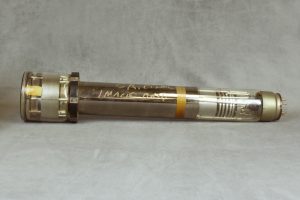How the Emmy got its name…
What do these two things have in common?


Not only are they both part of our collection, but they also share—in a corrupted form—a name. The photo on the right is of the first image orthicon tube (1943), the first cathode ray tube sensitive enough to capture moving images without needing immense amounts of light, thus making television as we know it more practical. Early RCA experiments in capturing moving images in the late 1920s, for example, trained the camera on a Felix the Cat figurine because nothing living could withstand the bright studio lights.[1] The photo on the right is of the Trustees Award Emmy presented to David Sarnoff in 1962 for his pioneering work in television technology.
Six years after the first prototype image orthicon was developed at RCA Labs, the Academy of Television Arts and Sciences (ATAS) wanted to establish an awards ceremony to honor the people in the relatively new field of television. After going through a number of proposals, the ATAS settled on the prize: a statuette of a woman holding an atom aloft. Now, all they needed was a name. The ATAS settled on the suggestion proposed by Harry Lubcke, third academy president and television engineer: “Immy” after the nickname that engineers gave revolutionary image orthicon. This name was soon modified to “Emmy,” thought to better suited for the female figure in the award.[2]
That the figure in the award is holding an atom aloft, and that the statue was named after a piece of technology, is not a coincidence. It reflects the American post-war views towards science and technology. WWII had shown the world the destructive force of the atom, but also opened up the possibilities for productive peacetime uses for it. The same was true of the image orthicon. First developed by RCA engineers Albert Rose, Paul Weimer, and Harold Law, the image orthicon that made modern television feasible were developed in conjunction with the U.S. War Department, who wanted to develop television-guided bombs.[3] It was technological breakthroughs undertaken at RCA for the war effort that made peacetime television possible.
RCA’s connection to the Emmys didn’t end with the name, however. We typically think of Emmy recipients as the stars who entertain us on our television sets, but an Emmy has always been awarded in the category of Outstanding Achievement in Technical Development. RCA as a corporation won its first Emmy in 1955, for the invention of the tricolor picture tube that made color television possible, followed by seven others (1960, 1973, 1980, 1982, 1983, 1984, and 1986) over the course of thirty years.[4] Although RCA and the people who worked there might not be good contenders in the category of outstanding lead actor in a drama series, or writer for a variety series, the company and its engineers nevertheless made the world of television possible.
Works Cited:
[1] The figurine that was used is now in the collection of the MZTV Museum in Ontario, Canada. “The First Star of Television,” http://www.mztv.com/ephemera/the-first-star-of-television/
[2] Sandra Parker, “History of the Emmy Statuette,” Academy of Television Arts and Sciences, http://www.emmys.com/academy/about/statuette
[3] Albert Abramson, The History of Television, 1942 to 2000, (Jefferson, N.C.: McFarland, 2003), pp. 7-10.
[4] “A Parade of Emmy Awards Spanning 30 Years,” Images, Winter 1986, p. 3.

